Fresh Start Giveaway
It’s that time of the school year where we all start looking toward the  future, to next school year and getting ready for a Fresh Start. This weekend, I am starting a Fresh Start of my own. Raki’s Rad Resources is moving over to a new logo and a new blog – www.rakisradresources.com . In order to celebrate my fresh start, I’d like to set you up with a Fresh Start Package. I’m going to be giving away these four Fresh Start Packages, each valued at over $35 worth of Quality Teaching Resources, at the new blog, and there’s a Fresh Start Freebie for all! So, stop by and sign up!
future, to next school year and getting ready for a Fresh Start. This weekend, I am starting a Fresh Start of my own. Raki’s Rad Resources is moving over to a new logo and a new blog – www.rakisradresources.com . In order to celebrate my fresh start, I’d like to set you up with a Fresh Start Package. I’m going to be giving away these four Fresh Start Packages, each valued at over $35 worth of Quality Teaching Resources, at the new blog, and there’s a Fresh Start Freebie for all! So, stop by and sign up!
Critical Thinking Games
It’s time for the Wednesday Website suggestion!! For two years, I was the Technology Specialist at a school in Georgia. During that time, I amassed a large collection of websites that I use with my students. If you want to search through some of them, you can check out my IKeepBookmarks site. Or, you can check back here each week for the Wednesday Website suggestion.
I don’t know about your kids, but my kids are really starting to tune me out. It might have something to do with there only being 32 days of school left. (How many days do you have?) So, I have been going through some of my website collections looking for something that will hold their attention. This week’s website of the week is Cool Math Games 4 Kids. If you’ve never visited their site – it’s an amazing compilation of math games that work on tons of math skills, including critical thinking. I spend a lot of time on critical thinking in my classroom, (In fact, I wrote a guest blog post for Fabulous Fourth Grade Froggies on critical thinking that you might want to check out.) so I have been working on these three critical thinking games with my students.
Be warned – these games are addictive to ADULTS as well as children, and can be played happily for hours, thereby draining you of your grading time! ![]()
 B-Cubed is a great critical thinking game. It is like a 3-d maze. Every time you move the yellow cube on top of a grey cube, it makes the grey cube disappear. The object of the game is to make all o the grey cubes disappear before you make the red cube disappear.
B-Cubed is a great critical thinking game. It is like a 3-d maze. Every time you move the yellow cube on top of a grey cube, it makes the grey cube disappear. The object of the game is to make all o the grey cubes disappear before you make the red cube disappear.
Bloxorz is a greatly addictive strategy game. You must twist and turn the tall box to get it through the hole. There are many, many levels!
Phit is a tetris-like game where you use all the pieces and try to get them to fit into the yellow box. It’s a great visual thinking game!
Hope you enjoyed this Wednesday’s Website suggestion – check back each Wednesday for a new Wednesday’s Website suggestion and click HERE to view previous Website suggestions.
Teach Well
My class consists of 19 students, of which only 1 speaks English only in his household, and even he began his life in a bilingual environment. The other 18 speak at least one, if not two other languages in their homes. Most of my students speak Arabic, but many also speak French. I have 3 who speak French and not Arabic, 1 who speaks Spanish, and 1 who speaks a Philippine dialect. All of my students speak SOME English, but to varying degrees. My job is to teach them English, while also teaching them everything we normally teach in school (reading, writing, math, science, social studies etc.) Fortunately, I am certified to teach ESL and have some experience with English Language Learners. Due to my unique teaching position, I have had some readers ask for tips on teaching English Language Learners. So, from now on, I will now be doing a Teaching Tip Tuesday geared especially towards teaching English Language Learners. Here’s this week’s Tuesday TESOL Teaching Tip:
ELL Teaching Tip #22: Don’t Forget Best Practices
A few years ago, I participated in SIOP (Sheltered Instruction Observation Protocol) training. SIOP is a model of teaching specifically designed to help English Language Learners gain more from content instruction in the general classroom. The training was wonderful and truly helped me with my English Language Learners, but the main focus of the training was simply utilizing “best practices”. We all know what best practices are – they are the tried and true strategies that give all students a chance to participate in learning in a hands-on manner that will increase understanding and improve the chances of comprehension and storage in long term memory.
comprehension and storage in long term memory.
So, the English Language Learner Teaching Tip of the Week is to remember to teach in the way you as a teacher know is best. English Language Learners may have some special needs, and need some special considerations – but in general they are just another student in your classroom who needs to learn. Strategies that help the rest of your students learn will help ELL’s learn too – especially if they are hands-on, collaborative, fully explained and modeled to students.
While we are all familiar with “best practices”, it is easy to get away from them in the reality of our classrooms. Here are a few reminders of some best practices that help our students – ELL or not:
1.) Model, model, model – rather than just talk about what students should do, model it! Show (don’t tell) students exactly where you want them to cut, how you want them to measure, how many counters you want them to use, which supplies you want them to use etc. For students who don’t have a lot of language, these visual models can greatly help them get the to understand the expectations.
2.) Think, pair, share – two heads are better than one. Give students a chance to share with each other and see if their thinking is on the right track. This strategy also give all students the opportunity to “share” to someone, thereby stopping the “But I NEVER get a chance to answer!”s.
3.) Use objectives – don’t assume students will know what you are teaching. Tell students what you are expecting them to learn, work on, and understand. By reviewing objectives with students, students have a clear idea of what thy need to do and a way to self-check and/or monitor themselves. Check objectives before AND after your lesson, so that students can monitor their learning.
Do you enjoy the weekly TESOL Teaching Tips? Do you want to know  more about teaching English Language Learners? I presented on this topic at the Everything’s Intermediate Expo on April 21st. If you missed the Expo, it’s not too late to catch the presentation, click HERE to find out how to view the presentation.
more about teaching English Language Learners? I presented on this topic at the Everything’s Intermediate Expo on April 21st. If you missed the Expo, it’s not too late to catch the presentation, click HERE to find out how to view the presentation.
Find more TESOL Teaching Tips here, and come back every Tuesday for a new tip!
Writing Journal Updates
Thanks to my proofreaders, I have been doing some massive updates on many of the products I have available on Teachers Pay Teachers. One of the updates I have up to this week is my Intermediate Writing Journals. I have updated the Narrative Journal and the Persuasive Journal. Tonight, I am going to try to get the Informational Journal done, and then I am hoping to get the Response to Literature Journal completely updated for the  big giveaway event that’s coming this Thursday (be sure to check back on Thursday for the details!)
big giveaway event that’s coming this Thursday (be sure to check back on Thursday for the details!)
In addition to sprucing the appearance of these journals up, I have added Student Reference Sheets and I have made them into official E-Books with clickable links on the Table of Contents, so that you no longer have to scroll through to find the page you want. Grab a free preview each of the two completed journals by downloading the free prompts – a week’s worth of writing on both the Narrative and Persuasive writing genres – from my Teachers Pay Teachers Store.
Earth Day Project
This week, my students have been learning about Earth Day. My students  are so excited to be participating in a collaborative project I’m hosting over at Global Teacher Connect. My students have signed pledges to not use plastic bags until May, we watched videos of whales sick from swallowing plastic bags, and we talked about why plastic bags are not good for the environment. Now, my kids run around the playground yelling at students who dared to bring their snack in a plastic bag!
are so excited to be participating in a collaborative project I’m hosting over at Global Teacher Connect. My students have signed pledges to not use plastic bags until May, we watched videos of whales sick from swallowing plastic bags, and we talked about why plastic bags are not good for the environment. Now, my kids run around the playground yelling at students who dared to bring their snack in a plastic bag!
Please feel free to stop by Project Page to check out the project, or spread the word about the project to other teachers who might be interested.
Virtual Teaching Expo Question and Answer
Today is the day we’ve been waiting for! It’s been a few months since I  announced that I would be presenting at the Everything’s Intermediate Expo. As of 12:01 am the Expo is live and ready for you to view. The goodie bag is ready to be downloaded – and what a goodie bag it is – 9 different quality teacher resources, including my set of 6 reading logs. (I was so excited to score some amazing resources from this goodie bag – including a Smartboard lesson from Laura Candler!) The interaction and learning is ready to begin!
announced that I would be presenting at the Everything’s Intermediate Expo. As of 12:01 am the Expo is live and ready for you to view. The goodie bag is ready to be downloaded – and what a goodie bag it is – 9 different quality teacher resources, including my set of 6 reading logs. (I was so excited to score some amazing resources from this goodie bag – including a Smartboard lesson from Laura Candler!) The interaction and learning is ready to begin!
Each presenter will have a Question & Answer post today, so please stop by their blogs and tell them what you thought about their videos. Here are quick links to their blogs:
Cara of Teaching… My Calling has done a wonderful presentation on Integrating Technology in the Classroom – with great, real life examples of how to use technology with your students.
Mor of A Teacher’s Treasure has made interactive notebooks simple and easy to understand, so you can start them with your class right away.
Janaye of Tales of Frogs and Cupcakes has some great suggestions on how to make math fun and meaningful for your students.
 And then there’s me! For those of you who don’t know my topic – I have 53 minutes for you on strategies for teaching English Language Learners, which is a passion of mine. We will be talking about all 4 domains: speaking, listening, reading and writing!
And then there’s me! For those of you who don’t know my topic – I have 53 minutes for you on strategies for teaching English Language Learners, which is a passion of mine. We will be talking about all 4 domains: speaking, listening, reading and writing!
So, click on over to the Expo and watch the videos – and then come back here and give me a 3-2-1! Have you ever done 3-2-1’s with your students? I love them – they are such a great, simple way to gauge comprehension, and start discussions, plus they provide a nice structure for English Language Learners. Here is a 3-2-1 for you. In the comment section:
Tell me 3 concerns you have for the English Language Learners you teach.
Tell me 2 questions you have about: teaching English Language Learners, my classroom, the strategies discussed in the video, or anything else you’re burning to ask.
Tell me 1 strategy you’ll take back into your classroom on Monday.
Rolling Into Literacy Skills
I LOVE to play board games at home, but I also enjoying using them in my classroom. In addition to encouraging cooperation, turn taking and a variety of other social skills, I find I can often use the games to work on math and literacy skills. So, every Friday, I am going to post a Friday Game Night post, giving tips on how to use a particular board game in your classroom. Here’s this week’s Friday Game Night Tip:
Dice – Part 2 (Literacy)
After two weeks of looking at playing cards, I decided to try one mo

1.) Roll a Word – Get students thinking by rolling up a word. Decide on a characteristic of a word (number of letters, number of consonants, number of vowels, number of syllables). Have students each roll a die and than share on a word that fits into the characteristics. ie. If you roll a six during the number of consonant round. you must come up with a word that has six consonants in it. This is great for building critical thinking and sharing vocabulary.
2.) Number Stories – Have students roll 3 or 4 dice and use them within their writing. For example, if they roll a 4, a 2 and a 1 – they must use those numbers in their writing. An example might be a story about 2 girls with 4 shoes and 1 pet.
3.) How Many Facts? – Do you want students to come up with a list of facts about a specific topic or category? Ask your students to roll a die (or two), and give them a topic or question. Then students will use the number on the die to know how many facts to give. ie. Ask students “What is the name of some animals that live in the rainforest?” Each student rolls a die to determine how many animals they have to come up with – rolling a six means coming up with six rainforest
4.) How Many Repetitions? – Get students to practice writing their spelling words with dice. For each spelling word – students will roll a die (or two). The number they roll will tell them how many times they must copy their spelling word. ie. If you roll a 4 for the word said – you will write: said, said, said, said
I hope some of these suggestions will help you use dice to teach math in a new and interesting way. Click HERE for more suggestions on how to use board games in the classroom.
Global Professional Development
Oh my goodness, the Everything’s Intermediate Expo is just days away!  On Saturday, April 21st, the Everything’s Intermediate Expo will be live, and it’s goodie bag will be live!
On Saturday, April 21st, the Everything’s Intermediate Expo will be live, and it’s goodie bag will be live!
When I moved to Morocco, I didn’t think I’d be presenting at a professional development seminar. I mean, I’m living in a country where I don’t speak the language! But, thanks to the internet I am! I have taped my video and I can’t wait to  see what the other teacher presenters have to say. I have recorded a presentation on strategies for teaching English Language Learners. There will also be presentations on: Integrating Technology, Using Interactive Notebooks and Modifying Math Instruction. I hope you have bought a ticket, so that you can receive all 4 hours of this amazing webinar. You have until Friday to purchase it for $15, then it’s $20, which is still a bargain for 4 hours worth of professional development! There’s even a certificate to print and certify that you have attended when you are submitting those Professional Learning Units! Plus, there’s an amazing goodie bag available for those who are viewing on Saturday, with 9 different teacher resources! I hope to see you there!
see what the other teacher presenters have to say. I have recorded a presentation on strategies for teaching English Language Learners. There will also be presentations on: Integrating Technology, Using Interactive Notebooks and Modifying Math Instruction. I hope you have bought a ticket, so that you can receive all 4 hours of this amazing webinar. You have until Friday to purchase it for $15, then it’s $20, which is still a bargain for 4 hours worth of professional development! There’s even a certificate to print and certify that you have attended when you are submitting those Professional Learning Units! Plus, there’s an amazing goodie bag available for those who are viewing on Saturday, with 9 different teacher resources! I hope to see you there!
Using Wallwisher as a Center
It’s time for the Wednesday Website suggestion!! For two years, I was the Technology Specialist at a school in Georgia. During that time, I amassed a large collection of websites that I use with my students. If you want to search through some of them, you can check out my IKeepBookmarks site. Or, you can check back here each week for the Wednesday Website suggestion.
Have you ever used Wallwisher? I have used it in multiple professional development activities, but I think lots of teachers overlook it’s uses in our computer center. So, this week’s Wednesday Website suggestion is www.wallwisher.com. This website is basically a 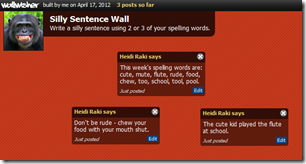 virtual interactive bulletin board, where different people can collaborate to join their ideas together by adding a “sticky note” to the wall. You can also add pictures, and videos to your sticky notes. It’s a great way to get kids collaborating, but it’s also an innovative way to collect information from your students and it makes an easy computer center. Here are some ways you can use Wallwisher in your classroom:
virtual interactive bulletin board, where different people can collaborate to join their ideas together by adding a “sticky note” to the wall. You can also add pictures, and videos to your sticky notes. It’s a great way to get kids collaborating, but it’s also an innovative way to collect information from your students and it makes an easy computer center. Here are some ways you can use Wallwisher in your classroom:
1.) Put a challenge up on your wall for students to complete when they come to the computer center. For example: Write a silly sentence using two or three of your spelling words.
2.) Assign your students a video (by adding the link to your post on the wall). After students have watched the video – they can answer a question about the video, tell you their favorite part, or even leave you a question about something they didn’t understand.
3.) Combine two great sites to make a dynamic listening center – Add the video links from www.storylineonline.net to a post. Let students listen to the story and then “summarize” the story in 160 characters or less (160 characters is the limit for each sticky note).
4.) Make a virtual “add a sentence” story – post a picture into a sticky note and write the first sentence of a story about that picture. Ask students to add one sentence to the story, by adding a sticky note and placing their sticky notes in order to make a story.
5.) Do Math Problem Solving in Reverse. Post a number sentence (2×5=10) to your question. Have students each add a sticky note with a self-created word problem that could use the number sentence.
BTW – I am taking the Organized Classroom Blog’s 5-Star Blogger Challenge. Stop by her blog for details, and please feel free to leave me a comment telling me if I am a 5-Star Blogger.
Hope you enjoyed this Wednesday’s Website suggestion – check back each Wednesday for a new Wednesday’s Website suggestion and click HERE to view previous Website suggestions.
Explaining Language Learning
My class consists of 19 students, of which only 1 speaks English only in his household, and even he began his life in a bilingual environment. The other 18 speak at least one, if not two other languages in their homes. Most of my students speak Arabic, but many also speak French. I have 3 who speak French and not Arabic, 1 who speaks Spanish, and 1 who speaks a Philippine dialect. All of my students speak SOME English, but to varying degrees. My job is to teach them English, while also teaching them everything we normally teach in school (reading, writing, math, science, social studies etc.) Fortunately, I am certified to teach ESL and have some experience with English Language Learners. Due to my unique teaching position, I have had some readers ask for tips on teaching English Language Learners. So, from now on, I will now be doing a Teaching Tip Tuesday geared especially towards teaching English Language Learners. Here’s this week’s Tuesday TESOL Teaching Tip:
ELL Teaching Tip #21: Explain the Language Learning Process to English Only Speakers
When I was in high school, I had a good friend, named Anastasia. She had started her school career in Russia, but had been at my school for awhile, so I didn’t think of her as anything other than another student in my class, and a fun friend to hang out with. However, one day in Social Studies class, I realized that the teacher was giving her extra time on her tests. Some of the other kids didn’t think this was fair, and in a very teenager way said as much. Rather than brush it off, my teacher took a minute to explain to us that even though Anastasia spoke a lot of English, she still often thought in Russian, and so when she read the test, she would often translate the information from English into Russian in order to understand it, and then have to translate it back to English before she wrote it down. For this reason, she took longer taking a test, and he gave her that time. His explanation made so much sense to me, that I remember that moment clearly to this day.
Often, we think that dealing with our English Language Learners only means teaching those who don’t speak English as their first language to understand how a new language is learned. However, most of the time, we have other students in our room, who are English Only Speakers. It is hard for students who only speak one language to understand the concept of thinking in two languages. (I am in the middle of learning a second language and it’s still hard for me to have that first hand understanding of being bilingual.) Rather than ignore it, or brush over it as “everyone learns differently”, take the time to explain to your English Only Students what your ELL students are doing in their brain every day, and you will see a new form of understanding and empathy in your classroom. Students will be more willing to be peer tutors and work collaboratively with your ELL’s, because they will better understand why these students need more assistance. – Do be careful not to make English Lanugage Learning into a handicap or a reason for English Only Students to do all the work for ELL’s – rather stress understanding the other’s point of view. 
It’s also great to give English Only Students a taste of what it feels like to not always know what is going on around them. Find videos in another language (there are plenty available on YouTube) and play them to the whole class (this is especially fun and easy if you can get movies in the home language of the majority of your ELL’s). Talk to the English Only Students afterwards about how it felt to not understand everything that was going on, and why this made it hard. This will help build empathy and understanding amongst your students.
Do you enjoy the weekly TESOL Teaching Tips? Do you want to know  more about teaching English Language Learners? I will be speaking on this topic at the Everything’s Intermediate Expo this weekend, and I’d love to have you “join” us. It is a virtual expo, which will help us connect no matter where we are! Click HERE for ticket information.
more about teaching English Language Learners? I will be speaking on this topic at the Everything’s Intermediate Expo this weekend, and I’d love to have you “join” us. It is a virtual expo, which will help us connect no matter where we are! Click HERE for ticket information.
Find more TESOL Teaching Tips here, and come back every Tuesday for a new tip!


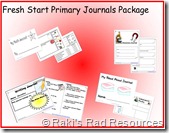

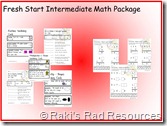



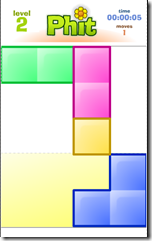

![signature_thumb1_thumb1_thumb_thumb_[1] signature_thumb1_thumb1_thumb_thumb_[1]](https://rakiradresources.files.wordpress.com/2012/04/signature_thumb1_thumb1_thumb_thumb_1_thumb.png?w=240&h=74)
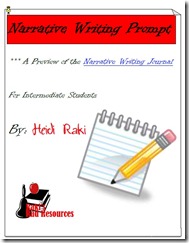






![signature_thumb1_thumb_thumb_thumb_t[1] signature_thumb1_thumb_thumb_thumb_t[1]](https://rakiradresources.files.wordpress.com/2012/04/signature_thumb1_thumb_thumb_thumb_t1_thumb1.png?w=240&h=74)






















